How Super Mario 3D World vindicates a 20 year rollercoaster of fandom
It’s an interesting experience, being a long-term Nintendo fan. The last 20 years have been a period of extreme, er, extremes. For the 16 years between the SNES and the Wii, we had it embarrassingly good. We were smiling, angel-winged pigs wallowing in rainbow coloured poop, under eternally blue skies on a particularly verdant corner of Moo Moo farm. Into our pen was poured a daily bounty of additional rainbow poop (which was naturally also made of chocolate and sparkled with dancing starmen in the sunlight). We were spoiled like the favourite grandchildren of an eccentric millionaire.
We’d long accepted that we bought Nintendo consoles primarily for the first-party games, years before the conspicuous lack of third-party support became a punching bag for Sony and Microsoft fanboys. We were happy for it to be that way, because a machine build around first-party Nintendo games was always a draw, not a hindrance. Yes, it was sad to see a third-party quotient increasingly made up of cheap, lazy pap during the Wii years, but on the whole it didn’t matter. Because we got Super Mario Galaxy, and Twilight Princess, and motion-controlled online Mario Kart. No-one else did. We were the lucky ones.
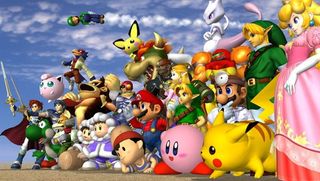
But here’s where the nuance of my point comes in. You see when I said a paragraph ago that Nintendo’s own games were always the primary draw, I didn’t mean, as the uninitiated may suspect, that we were enjoying more of the same year after year. A non-Nintendo fan, one who (I’m struggling to come up with a less patronising-sounding word, but I mean no offence when I’m forced to say) uneducated in our ways, could easily misconstrue Nintendo’s franchise-driven releases as a stream of perpetual rehashes. This had never been the case.
The one thing that typified Nintendo sequels, the one constant that kept its output as our first port of call at the start of every new console generation, was the fresh, surprising newness of every single game. Super Mario World wasn’t just Super Mario Bros. 3, part two. Twilight Princess wasn’t just a prettier version of Ocarina of Time. Nintendo sequels, seemingly by way of some unspoken but universally understood philosophy, always stayed true to the core essence of their series, but refocused and reimagined it in an entirely new way every time.
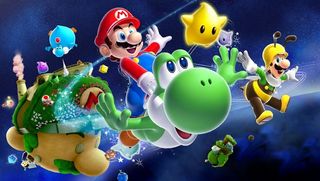
But somewhere along the line, something went wrong. I think it started with New Super Mario Bros. on the 3DS, a great platformer by most standards, but one that felt a little like a lovingly made tribute rather than a legitimate sequel. And the trend continued. The games were still great, but they lacked that wide-eyed surprise; that Christmas Day awe and wonder we had come to expect. Within the context of Nintendo’s shift away from its core audience, they became a bitter-sweet and slightly worrying series of games.
But Nintendo fans, famously, never give up hope. We always want the best, and above that, we always trust that Nintendo will eventually deliver it. Because we know that it can, when it puts its mind to the job. That’s why, for all of our philosophical disagreement, when myself and Henry publicly argued about the potential quality of Super Mario 3D World earlier this year, our two differing viewpoints came from the same place.
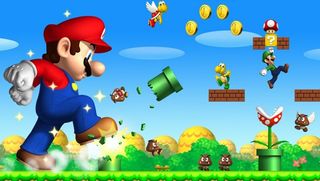
We both wanted a new, home console Mario game to live up to the joys of Marios past. It’s just that he was optimistically looking for signs of Galaxy and 64 in the then-upcoming game’s DNA, while I was in fear of another game that disappointed by retreading too much old ground. Particularly that of Super Mario 3D Land, a game which I actually adored for its fresh combination of tight, traditional 2D Mario design within the context of a pseudo-expansive 3D environment. As much as I loved 3DL, I felt that it had already been done. I didn’t want more. I wanted that new Mario game that I’d been waiting for. And I didn’t think that 3D World’s seeming similarity was going to provide that.
Sign up to the 12DOVE Newsletter
Weekly digests, tales from the communities you love, and more
But I was completely wrong. We both were. Because Super Mario 3D World, despite its superficial similarity to its pseudo-precursor, is a new type of Mario game entirely. It isn’t the isometric Galaxy that Henry was looking for, and it isn’t the shinier, multiplayer remake of 3D Land that I feared it would be. It’s entirely its own beast, and entirely a Mario game. And it claims that identity, as real Mario games always do, in a way entirely unseen before.
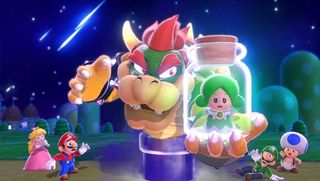
Unlike previous Mario games, it creeps up on you rather than hitting you in the face right from the title screen. As Henry said in his review, SM3DW eases you into its joyous, lunatic world of new surprises. Its first couple of worlds play out as a steadily expanding but safe evolution of what has gone before. But a little while later, something will happen. And when it does, the safe, enjoyable, but slightly predictable world you thought you were inhabiting will be turned on its head, as smooth as butter and without a single bump or bruise during transition. And your jaw will drop. And you’ll grin. And you’ll feel your eyes sparkle. And you’ll be playing a new Mario game again. Just like old times. The passed time between Super Mario World, Super Mario 64 and now will vanish, It will feel exactly the same as it always does. But better, just like it always does.
Maybe it will be the first appearance of Kuribo’s ice skate. Maybe it will be when you start to learn the ways in which the new cat suit seamlessly facilitates a whole new brand of Mario’s creative, playful, but weirdly instinctive secret-finding. Maybe it will be the way the inspired silhouette level puts another brand new spin on Mario’s core gameplay, or maybe it will be one of the countless other ingenious, inventive, one-shot surprises that the game is built out of, and that I’m certainly not going to spoil here.
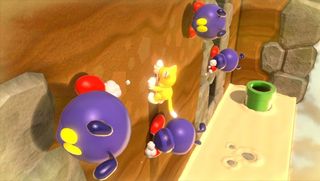
Maybe it will even be, as it was for me, the way that subtle little changes to the game’s structure make this Mario world feel like a real, cohesive place, and therefore part of the same, cohesive universe that the real Mario games have always existed within for long-time fans. Like the way that the traditional map screen becomes a fully-explorable, free-roaming environment, packed with secrets of its own and feeling for all the world like part of the same hub evolution we enjoyed between Super Mario Bros. 3, Super Mario World, and even Super Mario 64.
Or the way that new animations and behaviours for the enemy characters tell implicit mini-narratives, as Koopa Troopas mourn their lost shells, and the silent, long put-upon Goombas begin to feel like a tight, increasingly organised brotherhood, slowly increasing their skillset in the cause of long-overdue rebellion. Or the many references to other Mario games, even ones outside of the core series, that are so well integrated, and blended with core Mario gameplay with such insight and understanding, that they don’t feel at all like fourth-wall breaking shout-outs, but rather signifiers of a cohesive, unified world.
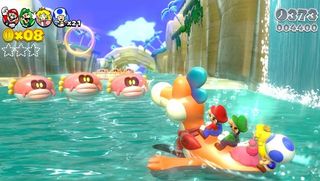
But whatever it is in Super Mario 3D World that gives you that feeling, something will. And it will make you smile, and laugh, or even cheer, and it will make you happy for the rest of the day. Just like Mario games always used to. But completely differently to how they always used to. Because completely differently is how they always used to do it.
And when that hits you, however that hits you, you’ll also laugh at the absurdity of any notion you’ve ever had that Nintendo had lost the magic, because Super Mario 3D World is made of it. It’s taken a little while to come back through, but it often does. But the important thing to remember is that it always does. That’s just the nature of being a Nintendo fan. So I’m not going to worry about it any more. It’s a long-term commitment, but I’m still one of the lucky ones. And if you get Super Mario 3D World, you will be too.
